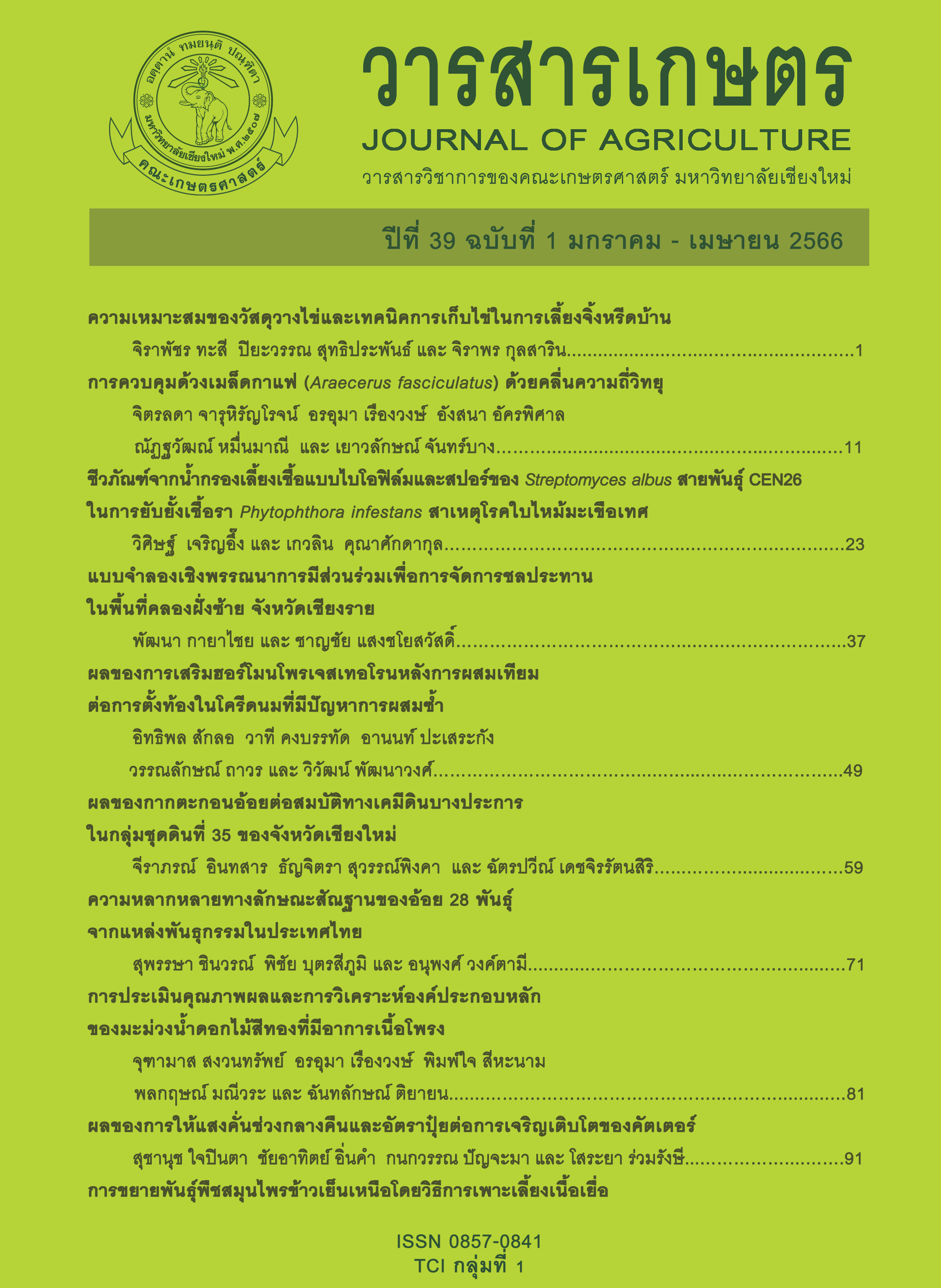การควบคุมด้วงเมล็ดกาแฟ (<I>Araecerus fasciculatus</I>) ด้วยคลื่นความถี่วิทยุ
Main Article Content
บทคัดย่อ
ด้วงเมล็ดกาแฟ Araecerus fasciculatus (Coleoptera: Anthribidae) จัดเป็นแมลงศัตรูกาแฟที่สำคัญเข้าทำลายเมล็ดกาแฟอะราบิกาและโรบัสตาในระหว่างการเก็บรักษา และทำให้ผลผลิตสารกาแฟเสียหายไม่เป็นไปตามมาตรฐาน การทดลองครั้งนี้เป็นการใช้คลื่นความถี่วิทยุ (radio frequency, RF) ควบคุมด้วงเมล็ดกาแฟที่เข้าทำลายกาแฟอะราบิกา ในการทดลองที่ 1 ทดสอบใช้คลื่นความถี่วิทยุ 27.12 MHz อุณหภูมิ 55 องศาเซลเซียส ระยะเวลา 90 วินาทีกับด้วงเมล็ดกาแฟในระยะไข่ หนอน ดักแด้ และตัวเต็มวัย พบว่า ด้วงเมล็ดกาแฟระยะตัวเต็มวัยมีการตายน้อยที่สุดเท่ากับ 46.43 ± 1.82 เปอร์เซ็นต์ แตกต่างอย่างมีนัยสำคัญทางสถิติ (P < 0.05) จากระยะไข่ หนอน และดักแด้ ซึ่งมีการตายเท่ากับ 100.00, 100.00 และ 97.35 ± 0.83 เปอร์เซ็นต์ ตามลำดับ ดังนั้นด้วงเมล็ดกาแฟระยะตัวเต็มวัยเป็นระยะที่ทนทานต่อการควบคุมด้วยการใช้พลังงานคลื่นความถี่วิทยุมากที่สุด ในการทดลองที่ 2 ทำการทดสอบใช้คลื่นความถี่วิทยุในการควบคุมด้วงเมล็ดกาแฟในระยะตัวเต็มวัย ซึ่งเป็นระยะที่ทนทานที่สุด ในระดับอุณหภูมิ 55, 60, 65 และ 70 องศาเซลเซียส เป็นเวลา 60, 90, 120 และ 150 วินาที (16 กรรมวิธี) และเปรียบเทียบกับชุดควบคุมที่ไม่ผ่านคลื่นความถี่วิทยุ พบว่า คลื่นความถี่วิทยุที่อุณหภูมิ 70 องศาเซลเซียส ระยะเวลา 60 วินาที สามารถทำให้ด้วงเมล็ดกาแฟระยะตัวเต็มวัยตายอย่างสมบูรณ์ (100 เปอร์เซ็นต์) และ ไม่สามารถให้รุ่นลูก (F1) ส่วนในกรรมวิธีที่ใช้คลื่นความถี่วิทยุที่อุณหภูมิ 60 องศาเซลเซียส ระยะเวลา 150 นาที และที่ระดับความร้อน 65 และ 70 องศาเซลเซียสเป็นเวลา 60, 90, 120 และ150 นาที พบว่า ด้วงเมล็ดกาแฟที่รอดจากการสัมผัสคลื่นวิทยุดังกล่าวมีสภาพไม่สมบูรณ์ ไม่สามารถให้รุ่นลูกได้ในสารกาแฟ
Article Details

อนุญาตภายใต้เงื่อนไข Creative Commons Attribution-NonCommercial-NoDerivatives 4.0 International License.
เอกสารอ้างอิง
Abbott, W.S. 1925. A method of computing the effectiveness of an insecticide. Journal of Economic Entomology 18(2): 265-267.
Buapud, A., Y. Chanbang and S. Vearasilp. 2012. Effects of radio frequency heating on Sitotroga cerealella (Olivier) and milling quality of rice cv. Khao Dawk Mali 105. Journal of Agriculture 28(2): 137-144. (in Thai)
Caasi-Lit, M.T. and I.L. Lit. 2011. First report of the coffee bean weevil Araecerus fasciculatus (De Geer) (Coleoptera: Anthribidae) as pest of papaya in the Philippines. Philippine Agricultural Scientist 94(4): 415-420.
Chaisri, R. and P. Suttiprapan. 2015. Biology of coffee bean weevil Araecerus fasciculatus (De Geer) (Coleoptera: Anthribidae) in garlic and Its control using carbon dioxide. Journal of Agriculture 31(1): 11-19. (in Thai)
Eduku, A., B.K. Maalekuu, P.D. Kaledzi and P.K. Tandoh. 2018. Development of bait for the management of coffee bean weevil, Araecerus fasciculatus in stored cocoa. Asian Research Journal of Agriculture 8(3): 1-11.
Faikrajaypuan, W., Y. Chanbang and S. Vearasilp. 2011. Effect of heat radio frequency on maize weevil (Sitophilus zeamais). Agricultural Science Journal 42(Suppl. 3): 392-395. (in Thai)
Jaramillo, J., A. Chabi-Olaye and C. Borgemeister. 2010. Temperature-dependent development and emergence pattern of Hypothenemus hampei (Coleoptera: Curculionidae: Scolytinae) from coffee berries. Journal of Economic Entomology 103(4): 1159-1165.
Jojo, S. and R. Mahendran. 2013. Radio frequency heating and its application in food processing: A review. International Journal of Current Agricultural Research 1(9): 42-46.
Kengkanpanich, R., K. Pengkum, J. Uraichuen, D. Suthisut, P. Noochanapai, S. Sitthichaiyakul, P. Pobsuk and R. Pongmee. 2018. Insects Found in Agricultural Produce and Their Control. The Agricultural Co-operative Federation of Thailand, Ltd., Bangkok. 224 p. (in Thai)
Ling, B., G. Tiwari and S. Wang. 2015. Pest control by microwave and radio frequency energy: dielectric properties of stone fruit. Agronomy for Sustainable Development 35: 233-240.
Mitcham, E.J., R.H. Veltman, X. Feng, E. de Castro, J.A. Johnson, T.L. Simpson, W.V. Biasi, S. Wang and J. Tang. 2004. Application of radio frequency treatments to control insects in in-shell walnuts. Postharvest Biology and Technology 33(1): 93-100.
National Bureau of Agricultural Commodity and Food Standards. 2018. Thai Agricultural Standard TAS 5701-2018 Arabica green coffee Ministry of Agriculture and Cooperatives ISBN 978-974-403-676-7. (Online). Available: https://www.acfs.go.th/standard/download/Arabica_coffee_bean_2561.pdf (March 23, 2020). (in Thai)
Nelson, S.O. 1973. Potential insect-control applications for microwaves. (Online). Available: https://digitalcommons.unl.edu/usdaarsfacpub/245/ (March 20, 2022).
Office of Agricultural Economics. 2021. Data of agricultural economics 2021. (Online). Available: https://www.oae.go.th/assets/portals/1/fileups/prcaidata/files/Varieties% 20coffee%2064.pdf (January 20, 2021). (in Thai)
Pan, L., S. Jiao, L. Gautz, K. Tu and S. Wang. 2012. Coffee bean heating uniformity and quality as influenced by radio frequency treatments for postharvest disinfestations. Transactions of the ASABE 55(6): 2293-2300.
Pornchalurmpong, P. and N. Rattanapanone. 2016. Radio-frequency (RF). (Online). Available: https://www.foodnetworksolution.com/wiki/word/3707/radio-frequency-rf-คลื่นความถี่วิทยุ (April 20, 2022). (in Thai)
Srikam, C., Y. Chanbang and N. Krittigamas. 2014. Use of radio frequency for controlling sawtoothed grain beetle (Oryzaephilus surinamensis) in milled rice cv. Khao Dawk Mali 105. Journal of Agriculture 30(3): 253-262. (in Thai)
Sumetha, K. 2009. Effect of radio frequency on Rhyzopertha dominica (Fabricius) (Coleoptera: Bostrichidae) and quality of rice cv. Khao Dawk Mali 105. M.S. Thesis, Chiang Mai University, Chiang Mai. 69 p. (in Thai)
Wang, S.-J. and J.-M. Tang. 2004. Radio frequency heating: A potential method for post-harvest pest control in nuts and dry products. Journal Zhejiang University Science A 5(10): 1169-1174.
Wang, S., J. Tang, R.P. Cavalieri and D.C. Davis. 2003. Differential heating of insects in dried nuts and fruits associated with radio frequency and microwave treatments. Transactions of the ASAE 46(4): 1175-1182.
Wang, S., G. Tiwari, S. Jiao, J.A. Johnson and J. Tang. 2010. Developing postharvest disinfestation treatments for legumes using radio frequency energy. Biosystems Engineering 105(3): 341-349.
Wangspa, W. 2016. Radio frequency heat treatment for controlling rice weevil in rough rice cv. Khao Dawk Mali 105 and their physical and chemical property changes. Ph.D. Thesis, Chiang Mai University, Chiang Mai. 116 p.
Wangspa, W., Y. Chanbang and S. Vearasilp. 2015. Radio frequency heat treatment for controlling rice weevil in rough rice cv. Khao Dawk Mali 105. Chiang Mai University Journal of Natural Sciences 14(2): 189-197.
Wintgens, J.N. 2004. Coffee: Growing, Processing, Sustainable Production: A Guidebook for Growers, Processors, Traders, and Researchers. Wiley-VCH Verlag, Weinheim. 976 p.
Wu, Y.-K., N.-B. Chen and G.-T. Ou. 2011. Damage of coffee bean weevil (Araecerus fasciculatus De Geer) on its new host Jatropha curcas L. Plant Diseases and Pests 2(2): 22-24.


